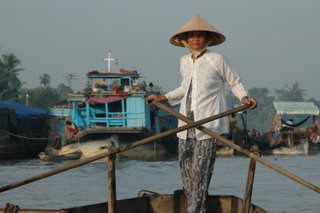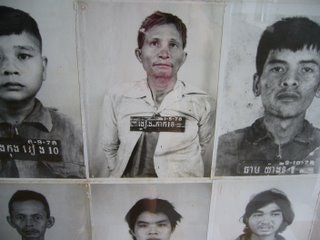A New Friend, the Mekong Delta to HCMC

I took a very unconventional route from Cambodia to Vietnam. I had to hire a private taxi - $22 :( - and I have no idea which of the two border crossings he dropped me at. Nonetheless, I was the only westerner around and I got some strange looks. One of the first things I noticed in Vietnam is the color. There are great pastels and bright blues, greens and purples on the houses. Cambodia and Laos, by contrast are primarily brown; thatched huts in rural areas and a sprinkling of earth tones in cities. Chau Doc, my first stop, is bustling. Zillions of people zipping about at a frenetic pace, noise, pollution, organized chaos. After a couple of hours I need a retreat and hop the next bus to Ha Tien, a town described in my guidebook as quaint. This bus does not ply a tourist route and as such it never gets full. When there can't possibly be more room, there is always more room. Literally, I had people sitting on top of me. This is funny for about 5 minutes. I don't think quaint is the right word, but Ha Tien does have an end of the road feeling to it. While I only saw two other Western travellers, there are many Vietnamese on the road here. In Cambodia and Laos locals travelling is rare, a luxury for the upper classes only. In Vietnam, mobility is one sign that this is a more developed country. Another is the wide range of businesses. In fact, it's not long before I meet Tuyet, a Ho Chi Minh native who helps her parents with their import / export business. She happens to be on the same Mekong Delta loop as me and after dinner with her sisters (snail picnic on the riverfront) we make plans to met up the following night in Can Tho. Tuyet speaks better-than-average English and it's great to have a conversation that goes beyond, "Where are you from?" She is 27, though she looks 20, and she is smart and worldly and we share many of the same philosophies and values. I have no doubt we would be close friends if she lived in the U.S. She smiles easily and says, "My friend Lan has a good sense of humor. I have a good sense of direction." Sounds to me like the perfect tour guides for Ho Chi Minh City. First though, I head off on the Mekong on a small, wooden 4-seater in search of the floating markets, just me and the driver. Truthfully, I was hoping for a photogenic little old lady in a conical hat since they usually drive the boats, but instead I got a non-descript 20-year-old. Oh well, this was still the way to go. Most tourists head off on these big boats and skirt the markets peering in. My little man bee-lined for the middle of the market, bumping and crashing our way to a rice and pork breakfast. Dozens of boats bump along, most sell vegetables, some hot coffee, with the occasional floating drug store thrown in. It's fascinating how the Vietnamese hustle-and-bustle takes to the water so easily. The Mekong Delta is a complete maze of waterways with hundreds of canals and of course this is where the mighty Mekong empties into the South China Sea.
My journey to Ho Chi Minh City (HCMC) is uneventful by Vietnamese standards and I arrive to find a bustling modern city, albeit one with a zillion motorbikes. I had been warned about the traffic here, but I found it better than Phnom Penh. Here, people follow common sense traffic rules, for the most part, the difference being that there are 100 times more people. HCMC has a very cosmopolitan feel to it and asides from the motorbikes and street-food vendors it could be a city in the US, "same same, but different," as the SE Asians say. (FYI - HCMC refers to a very large geographic areas and Saigon is used to describe only a few districts in the city center.) In the morning I struck out alone to visit the War Remnants Museum, previously the American War Crimes Museum. I can't explain at all how devastating and upset I felt. It's one thing to visit Cambodia's Genocide Museum, the whole time knowing it was "others" who committed the atrocities. It's a whole other emotional experience to witness the atrocities that my government committed. Napalm. Agent Orange. Decapitations. Environmental devastation.
Later I meet up with Tuyet and her two friends, Lan and Hieu for dinner. I ask why, given what my country has done to hers not a single person has shown animosity towards me, knowing that I'm American. "My people, she says, do not look to the past. We look to the future." Wow, that is an amazingly mature attitude. The conversation moves to lighter topics as we question Hieu's motives of keeping several girlfriends while claiming to be in love with one. "I am very confident in the looks," he says and I realize that men are the same everywhere. Throughout the evening the four of us are on two motorbikes, Lan and Tuyet constantly chastising Hiue for his poor tour guide skills. But I'm amazed how nimble they are on the motorbikes.
The next day I hop a motorbike 40 minutes to the suburbs to Tuyet's home and she takes me to the nearby Cu Chi tunnels, the Viet Cong's 250km underground lair. The tunnels are impressive, narrow and potentially claustrophobic. On the way back we stop at her brother's for lunch. A delicious caramel taste lingers in my mouth and I ask, "Tuyet, this is really good. Is it chicken?" "No, frog legs." "Oh." Dining with Tuyet, her friends and family has been a culinary adventure for my pedestrian taste buds. I've now had cow's liver and other unidentifiable parts that don't resemble a prime rib cut, some crazy vegetables I have never seen, and even a duck embryo eaten straight out of the egg!!!! Remarkably, everything has tasted really good, though I think I'll skip the embryos next time. Anyway, I'm munching away on a frog leg when I swear I hear a marching band. I must be imagining it, I decide, because we moved past the suburbs and we're in the countryside. Sure enough within minutes a marching band comes into view leading a funeral procession. This was the most colorful funeral procession I have ever seen; the hearse was ornate with every color in the rainbow. Tuyet says this is only for the rich. At night we pick up Lan and zoom into town for dinner and a visit to the park. The park, it turns out, is the only acceptable place for men and women to "cavort" publicly, and we can barely find a seat amidst the cuddling. It gets late and I hate to say goodbye, and though it's difficult for Vietnamese to get visas for the States, I hope someday they can visit me.
For photos of the Mekong Delta and HCMC, click here:
http://www.flickr.com/photos/39463330@N00/sets/72057594112030156/
For photos of the Mekong Delta and HCMC, click here:
http://www.flickr.com/photos/39463330@N00/sets/72057594112030156/



